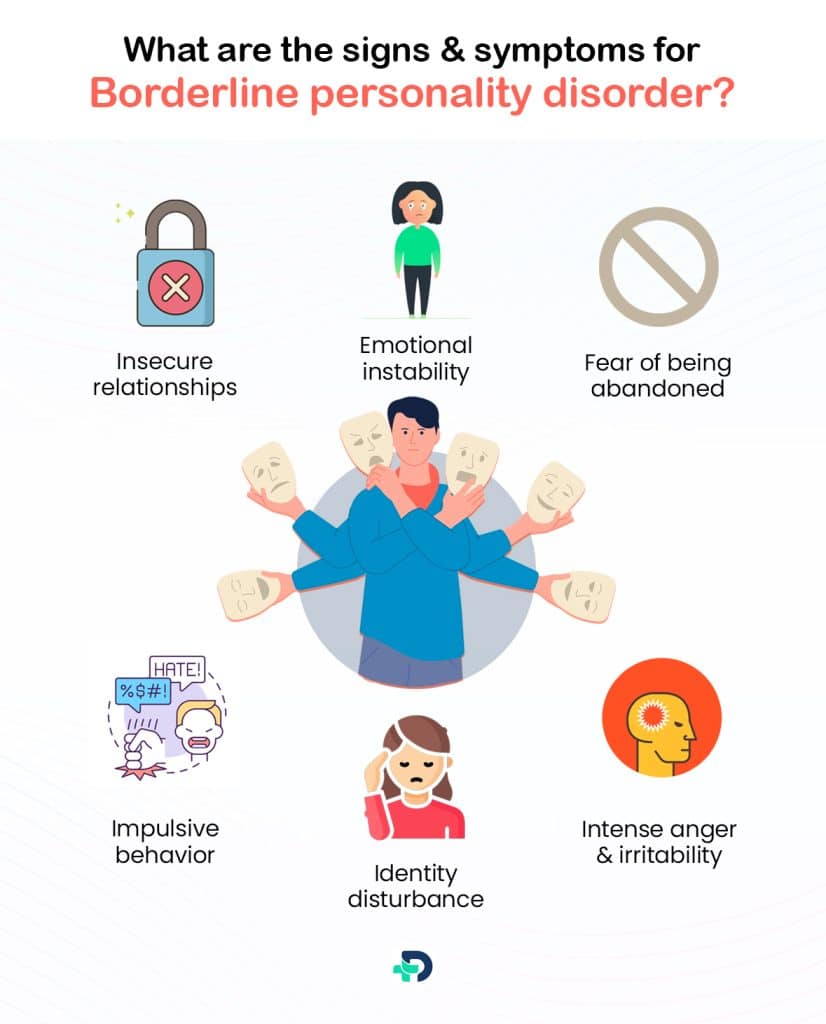Understanding Borderline Personality Disorder: Causes, Symptoms and Management

- Borderline Personality Disorder
- 22 Aug 2023
Overview
What is Borderline personality disorder(BPD)?
It is a mental disorder characterized by erratic emotions, actions, and interpersonal connections. People with BPD frequently have strong feelings, which can cause them to act impulsively and destructively. When the term “borderline” was first used, it implied that this state was on the cusp of psychosis and neurosis.
This page tries to shed light on its characteristics, signs, and effects on people’s life. We will also discuss its potential causes, risk factors, and the significance of a comprehensive treatment strategy.

Symptoms

What are the signs and symptoms?
Some typical symptoms of Borderline personality disorder(BPD) are:
- Emotional instability
- Fear of being abandoned
- Insecure relationships
- Impulsive behavior
- Identity disturbance
- A persistent sense of emptiness
- Intense anger and irritability
- Dissociation
Emotional instability
- People frequently go through profound emotional changes. They might quickly transition from a cheerful to a sad, angry, or worried state. These mood swings may occur for no apparent reason, or outside circumstances may bring them on.
Fear of being abandoned
- The overpowering fear of being abandoned or rejected by others grips many people. They might take considerable measures to prevent actual or imagined abandonment, which could cause them to act clingy or dependent.
Insecure relationships
- People frequently have erratic and turbulent relationships. Others may be alternately idealized and devalued by them, being viewed as either entirely good or completely terrible. This may lead to intense, rough relationships with frequent arguments and breakups.
Impulsive behavior
- People frequently act impulsively and destructively, especially when they are under a great deal of emotional stress. This can involve dangerous sexual behaviors, excessive eating, gambling, careless spending, and irresponsible driving.
Identity disturbance
- An unstable or disjointed sense of self may cause people problems. They could need help to develop a distinct and enduring understanding of who they are, what they want out of life, or their values and objectives. This may exacerbate feelings of emptiness and identity confusion.
A persistent sense of emptiness
- Many people are more likely to engage in self-destructive habits and attempt suicide. These are frequently used as a coping mechanism for extreme mental distress or a desperate plea for support.
Intense anger and irritability
- People can struggle with self-control, leading to frequent angry or irritable outbursts. This can feel overwhelming and out of proportion to the circumstances, ruining relationships or even resulting in physical altercations.
Dissociation
- Dissociative episodes occur when a person feels cut off from himself, their thoughts, or their surroundings. This can include having a dream-like experience, experiencing time slips, or feeling emotionally distant.1Symptoms| Researched based study from Nlm.nih.gov ,2Symptoms| Researched based study from Nlm.nih.gov ,3Symptoms| Researched based study from Nlm.nih.gov ,4Symptoms| Researched based study from Nlm.nih.gov
Causes
Causes of Borderline personality disorder(BPD)
The precise causes have yet to be discovered entirely. However, this condition’s development may be influenced by several genetic, environmental, and neurological factors. Considered contributing factors include the following:
- Genetic factors
- External factors
- Neurological factors
- Environment
- Emotional Instability
Genetic factors
- There is a hereditary component to it, according to studies. An increased chance of getting the illness may exist in those with a family history of the disorder or other mental health conditions.9Causes| Researched based study from Nlm.nih.gov
External factors
- The risk may be increased by early experiences, especially traumatic ones like abuse, neglect, or tumultuous relationships. The symptoms have been connected to adversity in childhood.
Neurological factors
- Brain imaging tests have revealed anomalies in neurobiology. These disorders affect brain parts that control emotion, impulse control, and social interaction. Serotonin and norepinephrine imbalances, in particular, have also been linked.
Invalidating environment
- Being raised in a setting where feelings and experiences are routinely ignored or dismissed. This might involve having one’s emotions routinely rejected or ignored, or it may mean being told that one’s emotions are incorrect.
Emotional instability
- People frequently struggle to control their emotions adequately. A confluence of neurological, environmental, and hereditary variables may cause this emotional disturbance.
- People with BPD often have increased emotional sensitivity and reactivity, resulting in intense emotional experiences and challenges with managing and getting over emotional pain.
It’s crucial to remember that even without these risk factors, a person can still get the condition; possessing them does not ensure they will. The onset is probably influenced by the interaction of several variables, including genetic predisposition and environmental events.1Causes| Researched based study from Nlm.nih.gov ,2Causes| Researched based study from Nlm.nih.gov ,3Causes| Researched based study from Nlm.nih.gov ,4Causes| Researched based study from Nlm.nih.gov
Diagnosis
Diagnosing Borderline personality disorder
A licensed mental health practitioner, such as a psychiatrist or psychologist, often makes the diagnosis. There are various steps in it:
Initial assessment
- The initial evaluation will be carried out by a mental health professional, who may also perform a clinical interview to learn more about the patient’s medical and psychiatric history, including any current symptoms and how long they have been present.
Diagnostic criteria
- To ascertain whether the person satisfies the requirements, consult the Diagnostic and Statistical Manual of Mental Health Disorders (DSD) by the American Psychiatric Association. It comprises particular BPD behavioral and symptom patterns.
Rule out any other conditions.
- It’s critical to rule out other hypotheses. Some symptoms are common to bipolar disorder, depression, and post-traumatic stress disorder (PTSD), among other mental health conditions.
Diagnostic interviews and assessments
- The mental health professional may use specialized diagnostic interviews or assessment tools like the McLean Screening Instrument for Borderline Personality Disorder (MSI-BPD) or the structured clinical interview for DSM-5 personality disorders (SCID-5-PD) to gather additional data and confirm the diagnosis.8Diagnosis| Researched based study from Nlm.nih.gov
Treatment
Treatment of Borderline personality disorder
An all-encompassing strategy is used for the treatment, including psychotherapy, medicine (in some situations), and support. The following are some typical tactics:
Treatment of Borderline personality disorder using Psychotherapy
Psychotherapy includes following methods:
DBT, or dialectical behavior therapy
- One of the most often-used treatments is this one. It aims to improve knowledge and abilities in four main areas: mindfulness, emotion control, distress tolerance, and interpersonal effectiveness. It teaches people how to control their emotions, deal with difficulty, strengthen their sense of self, and improve relationships.5Treatment| Researched based study from Nlm.nih.gov
Schema-focused therapy
- It aims to pinpoint and alter harmful fundamental beliefs and thought processes contributing to the symptoms. It enables individuals to manage their emotions better and fulfill unmet needs.
Cognitive behavioral treatment
- People can use this to recognize and change harmful ideas and behavior can be helpful when. When dealing with particular symptoms like impulsivity and helpfulness.
Mentalization-based therapy (MBT)
- It focuses on enhancing a person’s capacity to comprehend and analyze their ideas and feelings and those of others. It enables people to create more realistic and fair mental images of themselves and their interpersonal connections.
Treatment by using Medication
- It can manage particular symptoms or co-occurring diseases but is not a primary treatment. To treat depression, anxiety, mood swings, or impulsivity, doctors may prescribe antidepressants, mood stabilizers, and antipsychotic medications.
- It’s important to remember that while medication alone may not be sufficient, it may be combined with psychotherapy.5Treatment| Researched based study from Nlm.nih.gov
Supportive therapy
- Group therapy or support groups can be helpful because they offer a safe space to share experiences, gain knowledge from others, and build coping mechanisms. Peer support can provide validation and help lessen feelings of loneliness.
Self-help methods
- Exercise, a good diet, and enough sleep are self-care practices that can improve general well-being.
- Deep breathing, meditation, and journaling are all examples of stress management practices that may be learned and practiced to help control emotions and minimize worry.5Treatment| Researched based study from Nlm.nih.gov ,6Treatment| Researched based study from Nhs.uk ,7Treatment| Researched based study from Borderlinepersonalitydisorder.org
Any feedback on this article?
 This Articles content was accurate
This Articles content was accurate Very Informative Article
Very Informative Article I have a question or a comment
I have a question or a comment
 This article contains inaccurate content
This article contains inaccurate content This article was not helpful
This article was not helpful I have a question or a comment
I have a question or a comment
We appreciate your helpful feedback!
Checkout our social pages
References
-
National Library of Medicine
Borderline Personality Disorder | Causes | Symptoms
-
National Library of Medicine
BORDERLINE PERSONALITY DISORDER | Causes | Symptoms
-
National Library of Medicine
Borderline Personality Disorder | Causes | Symptoms
-
National Library of Medicine
Borderline Personality Disorder: Risk Factors and Early Detection | Causes | Symptoms
-
National Library of Medicine
Pharmacological Treatments for Borderline Personality Disorder: A Systematic Review and Meta-Analysis | Treatment
-
National Health Service
Borderline personality disorder | Treatment
-
National Education Alliance for Borderline personality disorder
Treating BPD | Treatment
-
National Library of Medicine
Diagnosing borderline personality disorder | Diagnosis
-
National Library of Medicine
Past, Present, and Future of Genetic Research in Borderline Personality Disorder | Diagnosis



































